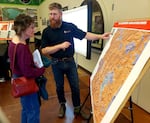
OSU researcher Andy McEvoy explains the new hazard categories to an Oregon property owner.
Juliet Grable / JPR
On Monday night, dozens of property owners crowded into a room at the Jackson County Expo in Central Point, Oregon, to learn about the revised map, which will be available for public comment in July. The open house was one of six planned for “high hazard” communities across the state.
The initial map, released in June 2022, was quickly withdrawn after widespread public outcry. The revamped version includes several major changes. Two hazard categories have been eliminated; now, properties will be grouped in one of three hazard zones: low, moderate, or high.
Irrigated croplands and pasture lands were also reassessed. In Josephine and Jackson counties, corridors along creeks now show up as green — low hazard — rather than orange or red.
“The change better reflects how on pasture lands and hay lands, fuel is only seasonally available,” said Andy McEvoy, wildfire researcher at the College of Forestry at Oregon State University, which developed the map. “The effect is to reduce the hazard on these lands.”
Related: What is your Oregon home’s risk of wildfire? New statewide map can tell you
A low hazard designation doesn’t mean that a fire can’t happen there; instead, the categories will help the state prioritize high-hazard neighborhoods and communities for mitigation.
“We’re trying to get ahead of a really significant problem that is already here that we’re already seeing in California,” said Chris Dunn, professor at OSU’s College of Forestry. “It’s starting to take communities out and it’s starting to impact our insurance markets, which is a collective resource that we all buy into.”
Two of the concerned property owners at the open house were Maxine Cass and her husband, Fred Gebhart, who live on their 20-acre property in Sams Valley in Jackson County, north of Medford.
They were there to learn about the status of the map and “if and how and when our insurance rates might be affected,” said Cass. They received a letter informing them that they were in the “extreme” or highest hazard category when the map was initially released in 2022. An Oregon law passed in 2023 explicitly prohibits insurance companies from using state wildfire hazard maps to raise rates, cancel policies, or refuse to renew coverage, but Cass and Gebhart don’t see how it can be enforced.
Hazard map first rolled out in 2022
The hazard map is a mandated outcome of SB 762, which was passed in 2021 a year after Oregon’s destructive Labor Day fires. OSU researchers created the map using two data sets: burn probability, or the likelihood that a fire will occur, and “fire intensity,” or how much energy a fire produces. These metrics in turn are based on four factors: climate, weather, topography and vegetation.
What the map doesn’t do is adjust a property’s hazard category based on steps an individual property owner may have taken, such as replacing a roof or removing vegetation from immediately around buildings.
Related: Work on wildfire risk map version 2.0 now under way in Oregon
The legislation also calls for the Oregon State Fire Marshal, or OSFM, to create a defensible space code and for the Building Codes Division to adopt “fire hardening” building code standards. Only properties designated as high hazard that are wholly or partly in the Wildland-Urban Interface — defined generally as the zone between developed and vegetated land — will be impacted by the new codes.
OSFM is taking an “educational over enforcement philosophy” around defensible space, said Chad Hawkins, assistant chief deputy at OSFM’s Fire Life Safety Division. The agency offers a free property assessment through its Defensible Space Program, which is carried out by local fire departments or OSFM personnel.
The fire hardening code will only apply to new construction or upgrades on an existing home, such as replacing a roof or siding.
Dunn, who led the science team that developed the map, admits there was a “complete disconnect” on how to engage the public during its initial rollout in 2022. People were confused about its purpose and alarmed by the official letters informing them of their hazard category.
“The narrative became, my insurance is getting dropped or going up; my home values are going down; and I’m going to have to spend $100,000 on my property,” said Dunn. He hopes that improved communication along with an improved map will help Oregonians consider how their properties fit in context with the “fire landscape” and what they might do to mitigate their vulnerability.
“The map is the beginning of the process, not the end,” said Dunn.
Related: How Oregon is mapping wildfire hazards
The remaining three open houses will take place in Grants Pass on June 20, in Klamath Falls on June 24, and in The Dalles on July 1.
A public comment period on the draft rules governing the map will run from July 1 to August 15. Public comment on the draft map itself will be accepted between July 18 and August 18. The finalized map will be published online on Oct. 1. Those in high-hazard zones whose properties are also within the WUI will be notified by letter. All property owners will have until Oct. 15 to appeal their property’s designation.